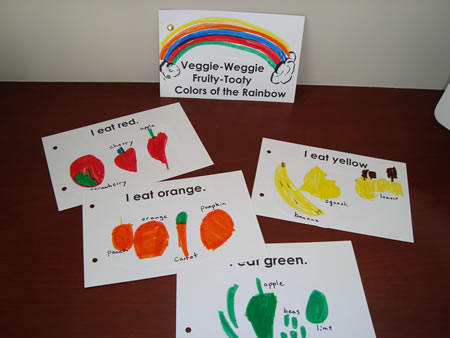Will you eat green, oh my children dear, (Pretend to strum a guitar as you sing.)
Will you eat green my children?
Oh, we’ll eat green (Make sign language for green by making a
Spinach, broccoli, and beans “G” and circling it around.)
Veggie-weggie, fruity-tooty (Make fists with hands and thump together.)
Fresh foody, colors of the rainbow. (Wiggle fingers in a arch like a rainbow.)
Let’s all eat green.
Will you eat orange, my children dear,
Will you eat orange my children?
Oh, we’ll eat orange things (Sign language for “O” and circle.)
Carrots, peaches, tangerines
Veggie-weggie, fruity-tooty
Fresh foody, colors of the rainbow.
Let’s all eat orange.
Will you eat yellow, my children dear, (Make a “Y” and circle.)
Will you eat yellow my children?
Oh, we’ll eat yellow corn,
Squash, pineapples, and more
Veggie-weggie, fruity-tooty
Fresh foody, colors of the rainbow.
Let’s all eat yellow.
Will you eat red, oh my children dear, (Make an “R” and circle.)
Will you eat red my children?
Oh, red we’ll eat
Apples, strawberries, and beets
Veggie-weggie, fruity-tooty
Fresh foody, colors of the rainbow.
Let’s all eat red.
Will you eat blue and purple, my children dear, (Make a “P” and circle.)
Will you eat blue and purple?
Oh, we’ll eat purple, blue
Grapes, plums, and berries too.
Veggie-weggie, fruity-tooty
Fresh foody, colors of the rainbow.
Let’s all eat purple and blue.
Oh what will you eat, my children dear, (Pretend to strum a guitar.)
Oh what will you eat, my children?
Oh, we’ll eat fresh foods
Good for us and the earth, too,
Veggie-weggie, fruity-tooty
Fresh foody, colors of the rainbow.
Let’s all eat green.
Activities:
• Make a rainbow snack with blueberries, strawberries, kiwi, grapes, and pineapple.
Clean the fruit and cut it into bite-size pieces. Children take wooden skewers and insert the pieces of fruit on the skewers to make a rainbow kabob.
• Brainstorm different parts of plants that you can eat.
Leaves – lettuce, spinach, cabbage
Stems – celery, asparagus, rhubarb
Roots – sweet potatoes, carrots, onions
Flowers – cauliflower, broccoli
Seeds – sunflower, pumpkin, walnuts
As you are eating lunch or snack, comment, “Mmmm! Don’t you love these leaves? How does that root taste? Would you like some more flowers?”
• What is a vegetarian? What do you eat that would make you a vegetarian? What do you eat that would make you a non-vegetarian?
• Plant a vegetable garden on the playground. (This would be a great project in which to involve some of your parents, grandparents, or others in your community.) Children will be delighted to grow, harvest, and eat their own vegetables. You can visit kidsgardening.com to learn more.
• Read STONE SOUP and ask each child to bring a vegetable from home. (You might want to ask the parents to wash and prepare the vegetables in bite-size pieces at home. Older kids will enjoy cleaning and chopping their own vegetables – with supervision!)
Wash some stones and place them in a crock-pot. Let children dramatize the story as they put their vegetables in the pot. Cover with vegetable juice or vegetable broth and simmer for several hours. Season with salt and pepper and enjoy!
• Take a field trip to the grocery store or farmer’s market. Look at labels to discover where fruits, vegetables, and other products come from. What does it mean to “eat local”? Are there any local foods in your market?
• Let children make predictable books of colorful foods they like to eat. For example: I like to eat red (strawberries, watermelon, etc.). I like to eat orange (carrots, sweet potatoes).
• Use a graphic organizer, such as a time line, to illustrate how fruits and vegetables go from the garden to the table.
|

